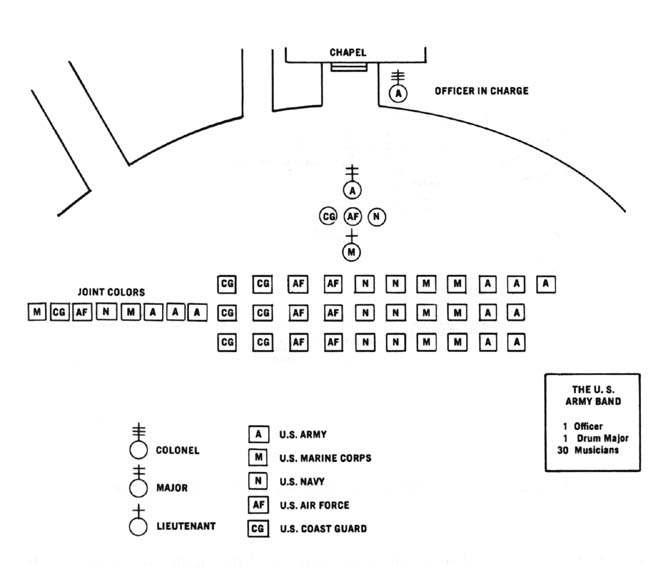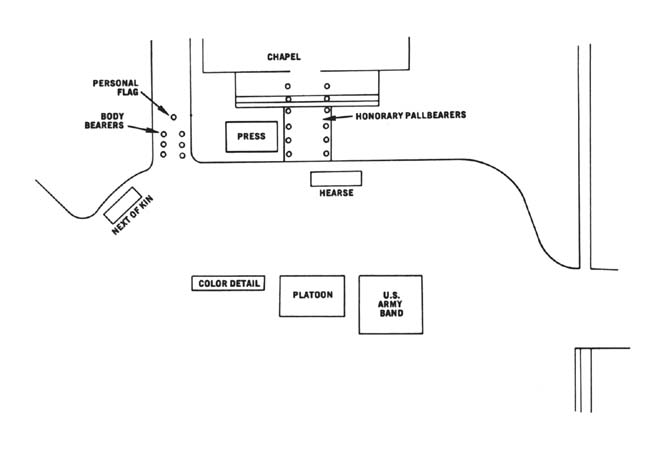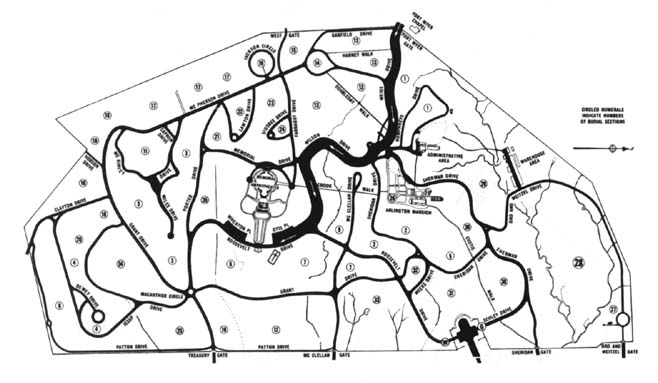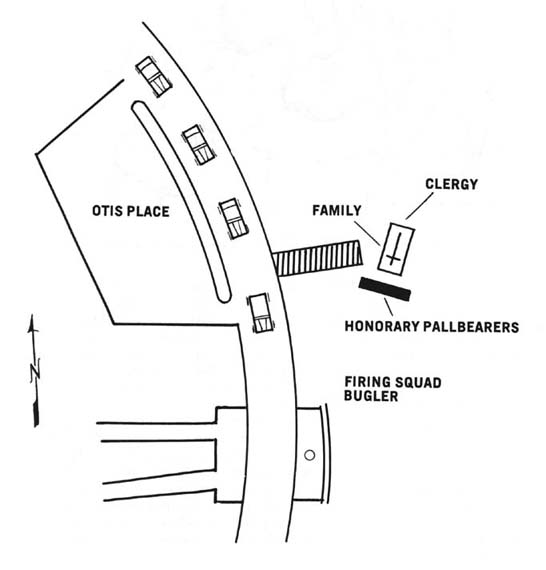|
The
Last Salute: Civil and Military Funeral, 1921-1969
CHAPTER XX
General Walter Bedell Smith
Special Full Honor Funeral
9-14 August 1961
On 9 August 1961 General Walter Bedell Smith suffered a heart attack
at his home in Washington and died in the ambulance on the way to Walter
Reed General Hospital. He was sixty-five years old and had retired.
From the hospital his body was taken to Gawler's funeral establishment
where it remained while funeral arrangements were completed.
By virtue of his rank, General Smith was entitled to a Special Full
Honor Funeral, in which the Army was the sole military service to participate.
But in deference to the wishes of Mary Cline Smith, the general's widow,
a distinctly different ceremony was actually held.
Mrs. Smith made her wishes known on the morning of 10 August, when she
conferred in the offices of Arlington National Cemetery with the officer
appointed from Headquarters, Department of the Army, as the official
aide to the next of kin, the ceremonies officer of the Military District
of Washington, and the assistant superintendent of the cemetery. At
that time she selected a gravesite for her husband in Section 7 of the
cemetery, very near the grave of General of the Army George C. Marshall,
and requested that his funeral be patterned after the simple joint service
funeral given General Marshall in 1959.
In line with existing policy which states that the officer in charge
of arranging a military funeral shall be from the same service as the
deceased, the Commanding General, Military District of Washington, Maj.
Gen. Paul A. Gavan, became responsible for planning the ceremonies for
General Smith. An immediate requirement facing General Gavan, raised
by Mrs. Smith's request that her husband's funeral be similar to General
Marshall's, was to obtain Department of Defense clearance for joint
service participation. This clearance was readily granted. General Gavan
and his staff then made plans based largely on the records of General
Marshall's funeral, but varying in several respects. The essential difference
was that General Smith's body would not lie in the Washington National
Cathedral as had the body of General Marshall.
General Smith's body was to remain at the funeral establishment until
midmorning on 14 August, when it was to be escorted to the chapel
at Fort Myer, Virginia, for a requiem mass. Immediately following the
chapel rites, a private
[168]

Diagram 48. Route of march, funeral establishment to
Fort Myer Chapel.
[169]
burial service was to be held at the Arlington gravesite.
At 1000 on 14 August a small escort arrived at the funeral establishment
to take General Smith's body to the Fort Myer Chapel. The morticians
had already placed the casket in the hearse, which one of them would
accompany. The escort included Metropolitan motorcycle police, two cars
of Armed Forces Police, and the escort commander, who in this instance
was a field grade officer from the 3d Infantry. The motorcade left the
funeral establishment at 1040, its departure timed so that it would
reach the chapel a few minutes before 1100, the scheduled hour of the
funeral service. (Diagram 48)
At Fort Myer most of the mourners were seated in the chapel before the
arrival of the cortege. Among them were high military officials, members
of Congress, and a number of foreign diplomats. President John F. Kennedy
was represented by his Army, Navy, and Air Force aides. Outside the
chapel fourteen honorary pallbearers formed a cordon at the entrance:
Morehead Patterson, Carter L. Burgess, General of the Army Dwight D.
Eisenhower, Louis Marx, David Marx, General George H. Decker, Robert
A. Lovett, Samuel C. Waugh, A. F. Wechsler, Robert Murphy, John Snively,
Marion Blazek, Paul Stone, and Allen W. Dulles. At 1055 the Smith family
walked through the cordon and entered the chapel.
Waiting near the honorary pallbearers was Bishop William R. Arnold,
Military Delegate to the Armed Forces of the United States from the
Office of the Military Ordinariate of the Catholic Church. Bishop Arnold,
who had been the Army Chief of Chaplains from 1937 to 1946, would conduct
the mass. Nearby were the body bearers, a joint service group composed
of two men from the Army and one man each from the Marine Corps, Navy,
Air Force, and Coast Guard.
Across the street from and facing the chapel stood an armed forces honor
guard, a joint service detail of seventy-six men which included an officer,
a drum major, and thirty musicians from the U.S. Army Band, a color
detail, and a platoon of troops. In command of the guard was an Army
major with a staff of three, one officer each from the Navy, Air Force,
and Coast Guard. The color detail was composed of one color guard each
from the Army and Marine Corps, two Army color bearers for the national
colors and Army colors, and one color bearer from each of the other
services carrying appropriate service colors. The platoon of troops
was commanded by a Marine Corps lieutenant and consisted of three ten-man
squads, each of which included two men from the Army, Marine Corps,
Navy, Air Force, and Coast Guard. One of the Army men in each squad
was the leader, and one other Army man with the formation was the platoon
guide. The honor guard elements were on line, the platoon in the center,
the color detail at the left, and the band at the right. During the
ceremonies for General Marshall the color detail was in the center and
the platoon at the left. (Diagram 49)
The cortege came to a stop between the armed forces honor guard and
the
[170]

Diagram 49. Position of armed forces honor guard at
Fort Myer Chapel.
chapel, the hearse at the chapel entrance. (Diagram 50) Bishop
Arnold, the mortician, the body bearers, and Col. Richard M. Lee, the
commanding officer of the 3d Infantry who was responsible for the ceremonies
at the chapel site, then moved to the rear of the hearse. At Colonel
Lee's signal the honor guard presented arms; the band sounded ruffles
and flourishes, played the "General's March," and then began
a hymn. While the hymn was played, the body bearers removed the casket
from the hearse and, preceded by Bishop Arnold, carried it through the
cordon of honorary pallbearers to the chapel entrance. There the casket
was placed on a movable bier; with the bishop still leading, two of
the bearers wheeled it to the front of the chapel. The honorary pallbearers
followed the casket into the chapel and were taken to their seats.
Bishop Arnold then said the requiem mass. At its completion, the honorary
pallbearers were first to be ushered from the chapel to allow them to
reform the cordon outside. Two body bearers moved to the front of the
chapel to handle the
[171]

Diagram 50. Formation for ceremony at Fort Myer Chapel.
casket. Bishop Arnold then led the procession out of the chapel, the
Smith family and other mourners following the casket.
The armed forces honor guard, which had remained in formation during
the funeral service, presented arms when Bishop Arnold appeared at the
chapel entrance, while the band sounded ruffles and flourishes and began
a hymn. As the hymn was played, the casket was returned to the hearse.
Those attending the private graveside rites then moved to their cars.
Members of the Smith family, who had waited at the chapel entrance while
the casket was carried to the hearse, were the last to enter their cars.
The honor guard again presented arms as the cortege began to move through
the gate into the cemetery. After the cortege had gone, the guard units,
none of which were scheduled for further participation in ceremonies,
were dismissed.
Since midmorning a detail of one officer and forty-four men from the
3d Infantry had been on station as a security cordon around the gravesite
to ensure privacy for the burial service. Inside this ring of troops
was another group of one officer and five men to control the press.
Also in position in the cemetery before the cortege reached the gravesite
were a saluting battery, a firing squad, a bugler, a national color
detail, and a personal
[172]

Diagram 51. Route of march, Fort Myer Chapel to gravesite.
flag bearer, all from the 3d Infantry, and a second armed forces body
bearer team of the same composition as that which had served during
the chapel rites.
Leading the cortege was the superintendent of Arlington National Cemetery,
Mr. John C. Metzler. Behind him came Colonel Lee, the honorary pallbearers,
Bishop Arnold, the hearse (accompanied by the mortician), and the Smith
family. To reach the gravesite the cortege moved via Meigs Drive, Wilson
Drive, and Roosevelt Drive. When it halted, the hearse was at the end
of a mat that ran from Roosevelt Drive to the grave. (Diagram 51)
The honorary pallbearers, who were the first to leave their cars, formed
a cordon along the mat. Bishop Arnold, the body bearers, the national
color detail, and the personal flag bearers took positions at the rear
of the hearse. The body bearers then removed General Smith's casket
from the hearse, and the procession, with the national color detail
leading and the mortician, the bishop, the casket, and the personal
flag bearers following in that order, marched through the cordon of
pallbearers to the grave. The honorary pallbearers fell in behind and
moved to their graveside position. The Smith family was then escorted
to the graveside by Mr. Metzler. (Diagram 52)
Bishop Arnold conducted the burial service. After the benediction, the
saluting battery fired seventeen guns, the firing squad discharged three
volleys, and the bugler sounded taps. As the last note faded, the body
bearers performed the ritual of folding the flag that had draped General
Smith's casket. One of them handed
[173]
it to Mr. Metzler, who in turn passed it to Bishop Arnold. The bishop
then presented it to Mrs. Smith. The rites for General Smith, as Mrs.
Smith wished, had been conducted with the simplicity and dignity that
had marked the ceremony for General Marshall.

Diagram 52. Formation at the graveside.
[174]
Previous Chapter
Next Chapter
|





